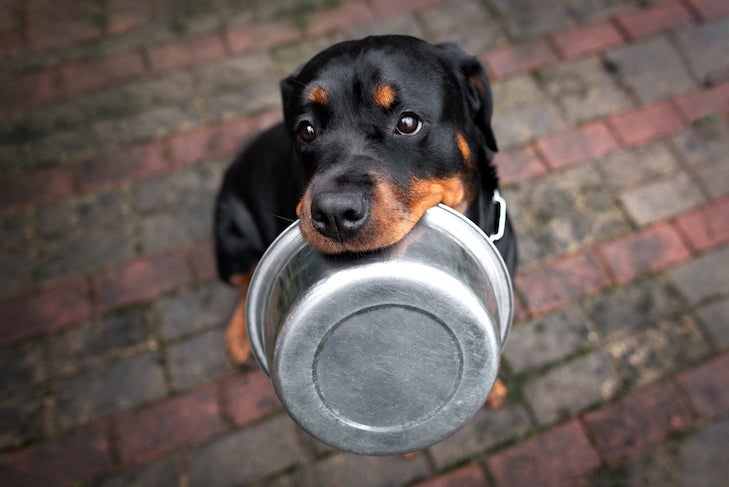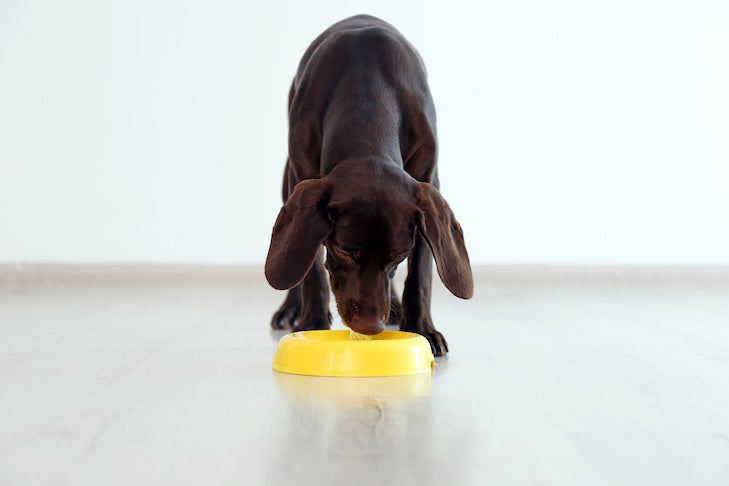
AKC is a participant in affiliate advertising programs designed to provide a means for sites to earn advertising fees by advertising and linking to akc.org. If you purchase a product through this article, we may receive a portion of the sale.
Some dogs are slow eaters, taking their time to chew every little piece and enjoy each bite. Others seem to swallow their food whole without even bothering to consider what it is they’re eating. They eat so fast you can barely blink an eye before the entire meal is gone. These dogs come in all shapes, sizes, and breeds. Unfortunately, eating so quickly can be quite dangerous for our dogs.
First, they can choke, which is obviously life-threatening. Gagging on their food will often result in vomiting and discomfort, as well.
Second, eating quickly increases the risk of a serious medical condition called bloat. Bloat (formally known as gastric dilatation-volvulus or “GDV”) occurs when the stomach (or intestines) expands and may twist within the abdomen. This is immediately life threatening, and dogs will go into shock very quickly. When a dog eats too fast, he gulps down an excessive amount of air along with his food, causing the expansion and, therefore, increasing the chances of bloat.
There is also a condition called “food bloat” which is not a true GDV. It is just huge amounts of food that have been ingested sitting in the stomach. This condition does not cause shock. However, if there is even a remote chance a dog appears bloated, it should be seen by a veterinarian immediately. (Hint: a dog with true GDV will retch and vomit mostly foam, rarely food.)
So how can we help our dogs eat at a slower pace? Unfortunately, we can’t just sit them down and have a talk about safety. But there are some creative ways to help encourage healthy consumption, and with so many options, you’re almost certain to find one your dog enjoys.

- Slow-Feeder Bowls: There are many different brands of slow-feed dog bowls available on the market specifically for dogs that eat too quickly. All of them seem to do a great job, but you might want to read reviews to make sure people have had good success using a specific product with a dog similar to yours. You can also make your own slow-feeder bowl by using two bowls to feed your dog. Take a bowl one or two sizes larger than your dog’s regular dish and set it down flat, then take your dog’s regular dish and place it upside down into the large bowl. This will create a gap between the two bowls that you can fill with your dog’s food. Since the gap is big enough for your dog to reach the food, but not so big that he can take gulps, he’ll be forced to eat more slowly.
- Food Puzzles: Food puzzle toys are another excellent way to slow down your dog’s eating. They are similar to slow-feeders, as they are generally comprised of different nooks and crannies for your dog’s food to fit into, therefore making it impossible for your dog to take large gulps of food. There are many different puzzles available, from ones that lie flat on the ground to toys that dispense food while your dog plays with them, and all are viable options.
- Cookie Sheet or Muffin Pan: Spreading your dog’s food across a cookie sheet makes it very difficult for your dog to gulp down large amounts, especially if you feed kibble. Your dog will be forced to take tiny bites and pick up a lot of pieces with his tongue (which takes quite a bit of time), and therefore will eat much more slowly. The same goes for using a muffin pan. Fill each small muffin cup with a little bit of food, and use the entire pan. Even if your dog’s muzzle can reach easily into the cups, the meal will be broken down into smaller portions, and the excessive gulping will be eliminated.
- Hand Feed: Some dogs love being hand fed. While many owners don’t necessarily have time to sit there and hand feed their dogs, you can use training time as mealtime. Use your dog’s regular food as rewards during obedience training or any other training. Consider working on various tricks for food, and break everything down into small steps. This makes mealtime fun and safe, since your dog won’t be able to inhale large amounts of food.

